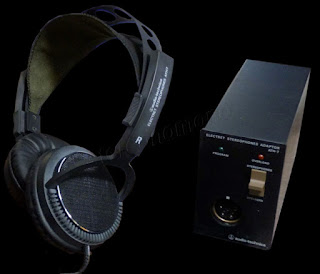The Onkyo
TX-7000 Quartz-Locked AM/FM Stereo Receiver is an outstanding example. Both its
power amplifier and FM sections are rich with important new design concepts.
The
TX-7000's power amplifier provides two major innovations never before present
in a stereo receiver. The first is called Super-Servo and it totally eliminates
the sonic "ghost signals" common to DC power amplifiers. As a result,
each instrument and voice sounds purer and more individually real regardless of
volume level. Perhaps for the first time, you'll experience stereo with true
depth, spaciousness, and a remarkably discernable third dimension. The second
innovation is Linear-Switching which lets us provide Class A amplifier sound
quality with Class B power efficiency. Crossover distortion is significantly
reduced. And output power is very highly efficient, 90 watts per channel with
no mote than 0,02% T.H.D.
The
TX-7000's FM section is also clearly superior, picking up weak stations
noiselessly and strong stations without distortion.
A unique
Human Touch Sensor automatically controls the Quartz-Locked system for more
reliable and convenient operaation, releasing the system instantly when it
senses your touch on the tuning knob engaging it again as your fingers leave
the knob. Special circuits also monitor both channels detecting and cencelling
out sound distorting FM signal noise. Other circuits cancel out appliance
noise. Digital FM readout, separate bass, mid and treble controls, 2-way tape
dubbing facilities, and dozens of other important features are all found in the
TX-7000. and the TX-7000 is just one of four new receivers from Onkyo Hear
"the secret of Onkyo" hear receivers so advanced, they transcend mere
technology.
Specifications
Amplifier
Power: 90 watts per channel, min. RMS, at 8 ohms both channels driven, from 20
- 20,000 Hz no more than 0,02% T.H.D.
Total
Harmonic Distortion:
0,02% at
rated power
0,018% at 1
watt output
IM
Distortion:
0,02% at
rated power
0,018% at 1
watt output
Damping
Factor: 50 at 8 ohms
Frequency
Response: 10 Hz - 30,000 Hz (±1 dB)
RIAA
deviation: 20 Hz - 20,000 Hz (±0,3 dB)
Input
Sensitivity/Impedance:
Phono : 2,5 mV / 50 k Ω
Tape Play
: 150 mV/50 k Ω
Tape Rec
: 150 mV/3,5 k Ω (PH)
Phono
Overload: 200 mV RMS at 1 kHz, 0,02%
T.H.D.
Signal-to-Noise
Ratio:
Phono : 76 dB (IHF A weighted, 1 watt output, 5 mV
input); 86 dB ( A weighted, 10 mV input)
Tape : 80 dB (IHF A weighted, 1 watt output, 0,5 V
input); 96 dB (A weighted)
Residual Hum
and Noise: 0,5 mV at min.volume level (A
weighted)
Tone
Controls:
Bass : ±13 dB at 100 Hz
Mid : ±5 dB at 1 kHz
Treble
: ±10 dB at 10 kHz
Filters:
High : 6 kHz, 12 dB/oct
Subsonic
: 10 Hz, 12 dB/oct
Loudness
(-40 dB): +8 dB at 40 Hz; +5 dB at 20 kHz
FM Tuner
Section
Tuning
Range: 88 - 108 MHz
Usable
Sensitivity:
Mono : 9,8 dBf (1,7 µV)
Stereo
: 17,2 dBf (4,0 µV)
50 dB
Quieting Sensitivity:
Mono : 14,7 dBf (3,0 µV)
Stereo
: 35 dBf (31 µV)
Capture
ratio: 1,3 dB
Image
Rejection Ratio: 90 dB
IF Rejection
Ratio: 100 dB
Spurious
Rejection ratio: 95 dB
Signal-to-Noise
Ratio:
Mono : 74 dB
Stereo
: 68 dB
Alternate
Channel Att: 70 dB
Am
Suppression Ratio: 55 dB
Harmonic
Distortion:
Mono : 0,15%
Stereo
: 0,3 %
Frequency
Response: 30 Hz - 15,000 Hz (±1,5 dB)
Stereo
Separation: 40 dB at 1 kHz; 34 dB at 100 Hz - 10,000 Hz
Muting
level: 17,2 dBf (4 µV)
Stereo
Threshold: 17,2 dBf (4 µV)
Quartz lock
level: 17,2 dBf (4 µV)
AM Tuner
Section
Tuning
Range: 525 - 1620 kHz
Usable
Sensitivity: 25 µV
Image
rejection Ratio: 45 dB
IF Rejection
ratio: 40 dB
Signal-to-Noise
Ratio: 40 dB
Harmonic
Distortion: 0,8%
General
Section
Antennas:
FM : 300 Ω balanced and 75 Ω unbalsnced
AM : built-in ferrite core and external terminal
Semiconductors: 2 FETs, 63 Transistors, 18 ICs, 47 Diodes
Power
Supply: AC 120 V, 220 -240 V, 50/60 Hz
Dimensions
(W x H x D): 575 x 146 x 462 mm
(22-5/8" x 5-3/4" x 18-3/16")
Weight: 19 kg (41,8 lbs)



































